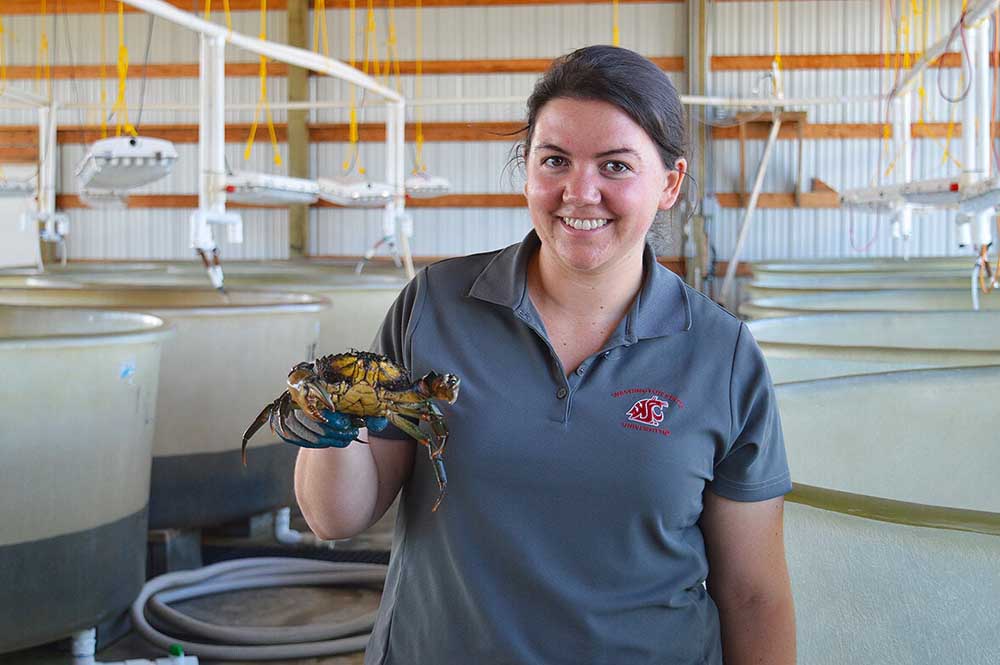Entomologist aids cranberry, shellfish growers
Published 2:45 pm Wednesday, October 18, 2023

- Washington State University Extension specialist Laura Kraft holds a European green crab, an invasive species in southwest Washington coastal waters.
LONG BEACH — As a middle-schooler, Laura Kraft learned about an invasive plant in Europe popularly known as “killer algea.”
Trending
She tried to get a sample until her potential source realized she was in the U.S., which bars killer algea from its shores. It was an early lesson in regulations and an early sign she is fascinated with invasive species.
“I wanted to have my own research on it,” she said. “It was very thoughtful for an eighth-grader, but I’m very relieved noxious weeds were not put in my hands.”
In the intervening years, Kraft, 29, has earned her bachelor’s and master’s degrees and her doctorate, all in entomology. Last December, she became the Washington State University Extension specialist on the Long Beach Peninsula.
Trending
Cranberry, shellfish help
Like her predecessor, Kim Patten, Kraft will help cranberry farmers and shellfish growers battle pests. She’s ready to battle cranberry tipworm, burrowing shrimp and European green crabs.
“I’m glad I came here,” she said. “What really stood out to me was that the cranberry and shellfish growers know each other. There’s a strong sense of community.”
Kraft grew up in Milton, Georgia, an Atlanta suburb. Asked what Milton is famous for, Kraft said, “Heavy traffic.” She had a connection to Washington as a girl. She visited an aunt in Whatcom County and picked raspberries.
She got an early lesson in the link between food and pests while in high school. She went to a store and was shocked by the high price of blueberries, a blow to a self-described “fruit fanatic” whose favorite food is blueberries.
She later learned about the spotted-wing drosophila, a fruit fly, and how much damage it does to blueberries and other fruit.
Cranberry tipworm is not in spotted-wing drosophila’s league in causing damage. But it is a tiny insect that, as the name suggests, eats the growing tip of cranberry vines. A search is underway for an effective pesticide.
Burrowing shrimp
The burrowing shrimp has long been a big problem for oyster growers. As its name suggests, the shrimp burrows in oyster beds and “essentially causes oysters to drown,” Kraft said.
“Our growers, when you speak to them, their number one concern is the burrowing shrimp,” Kraft said.
Patten tested mechanical methods of removing shrimp, but the shrimp burrow deep. After a decade of research, Patten concluded a pesticide, imidacloprid, was the only plausible option.
The Washington Department of Ecology gave oyster growers permission to spray the pesticide in 2015. After a flurry of bad publicity centered in Seattle, the oyster growers abandoned the plan.
The growers tried again in 2018, but this time Ecology switched positions and denied permission to spray.
Kraft said a new mechanical method may help, an amphibious buggy that causes shrimp to shoot to the surface and become prey for birds.
A question is whether a buggy would do more damage to tideflats than good, she said.
“It’s easy to point fingers and say, ‘Pesticides are bad,’ while not considering that the alternatives are potentially worse,” Kraft said.
European green crabs
The European green crab has emerged in the last few years as a priority for the state to battle. The crab was first found in Southwest Washington waters in 1998. The state didn’t declare an emergency until 2021 when the crab was found in Puget Sound.
“That was the cause for major concern,” Kraft said. “Part of the trouble with this pest is it travels so easily up and down the coast.”
The state’s only method so far of killing European green crabs is to trap them. Tribes, oyster growers and the state trapped about 65,000 crabs over three months last spring, including about 62,000 in southwest Washington waters.
The Department of Fish and Wildlife hasn’t enlisted the public’s help in trapping crabs for fear native crabs will be mistaken for the invaders.
Fish and Wildlife recently reported to lawmakers that “great progress” has been made fighting the crabs. Kraft said strides are being made, but warned the European green crabs will be hard to beat.
The invasive crabs have been on the New England coast for much longer and are thriving. “As bad as it is right now, it could get worse,” Kraft said.
Researchers don’t know how the crabs are affecting shellfish. In captivity, the crab has cracked open hard-shelled oysters. That may not reflect what’s happening in the wild, Kraft said.
“We don’t have a great idea of what the impact will be to the shellfish industry in southwest Washington,” she said.
“I think we’re just at the beginning of the management problem in Washington state,” she said. Whether pesticides will be needed, “I think we’re all wondering the same thing,” Kraft said.
Laura Kraft Age: 29 Position: Washington State University Extension cranberry and shellfish specialist in Long Beach Education: Bachelor’s and master’s degrees in entomology, University of Georgia; doctorate in entomology, North Carolina State University. Sideline: Wedding photographer
Age: 29
Position: Washington State University Extension cranberry and shellfish specialist in Long Beach
Education: Bachelor’s and master’s degrees in entomology, University of Georgia; doctorate in entomology, North Carolina State University.
Sideline: Wedding photographer








